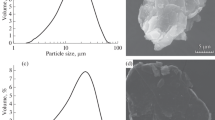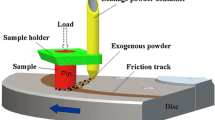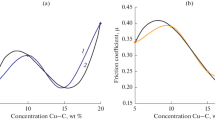Conclusions
In friction at a sliding rate of 40 m/sec and a pressure of 0.1 MPa. a finely disperse mixture of particles of copper and its oxides forms on the surface of pure copper; these particles increase the strength of the surface layer of copper, reduce its wear, but do not prevent bonding processes from taking place.
In friction of DGr-5 material at a sliding speed of 11 m/sec under a pressure of 0.1 MPa., surface films consisting of ultradisperse particles of copper and oxides form; the dimensions of the graphite particles are comparable with those of the initial particles. Since the graphite particles cannot extend completely along the prismatic planes to the friction surface and the amount of graphite is insufficient for ensuring the lubricating effect, DGr-5 material is not capable of efficient operation in these conditions.
The surface films formed during friction on DGr-10 composite material are characterized by uniform distribution of the graphite particles and consist of ultradisperse copper and fineplate textured graphite with preferential orientation with the basal planes parallel to the friction surface; this results in higher values of the tribotechnical characteristics.
Similar content being viewed by others
Literature cited
F. P. Bowden and D. Teibor, Friction and Lubrication of Solids [Russian translation], Mashinostroenie, Moscow (1968).
B. I. Kostetskii, Friction, Lubrication, and Wear in Machines [in Russian], Tekhnika, Kiev (1970).
A. Schilling, D. Solondz, and S. Kampf, “Electron microscopic examination of the dislocation structure of the subsurface zone of metals in examination of sliding friction,” in: Theoretical and Applied Problems of Friction, Wear, and Lubrication of Machines [Russian translation], Nauka, Moscow (1982).
L. M. Rybakova and L. I. Kuksenova, Structure and Wear Resistance of Metal [in Russian], Mashinostroenie, Moscow 1982.
I. M. Lyubarskii and A. S. Palatnik, Metal Physics of Friction [in Russian], Metallurgiya, Moscow (1976).
B. I. Kostetskii, I. T. Nosovskii, A, K. Karaulov, et al., Surface Strength of Materials in Friction [in Russian], Tekhnika, Kiev (1976).
V. V. Nemoshkalenko, V. I. Gorskii, V. V. Tikhonovich, and R. A. Yakubov, “Electron microscopic examination of the surface friction layers,” Metallofizika,6, No. 6, 93–95 (1984).
S. M. Kaufman, “Electron metallography of iron-base p/m materials,” Int. Powder Technol.,10, No. 4, 257–264 (1974).
I. M. Fedorchenko, N. G. Baranov, and V. F. Britun, “Examination of the friction mechanism of macroheterogeneous composite materials,” Trenie Iznos,3, No. 4, 601–609 (1982).
A. N. Pilyankevich, V. S. Britun, Yu. G. Tkachenko, and V. K. Yulyugin, “Structure of the changes in the surface layers of aluminum nitride in friction,” Poroshk. Metall., No. 6, 76–81 (1984).
I. M. Fedorchenko, N. G. Baranov, and V. F. Britun, “Mechanism of formation of surface films in friction without lubricating composite materials,” Trenie Iznos,5, No. 3, 424–430 (1984).
A. N. Pilyankevich, V. S. Britun, Yu. G. Tkachenko, and V. K. Yulyugin, “Structure of surface layers of boron carbide after friction in the temperature range 20–1400°C,” Poroshk. Metall., No, 8, 93–97 (1986).
I. I. Grabar, “Some relationships governing the formation of the structure of metal in friction,” Trenie Iznos,2, No. 6, 1076–1084 (1981).
“Equipment for friction and wear testing antifriction materials at speeds of up to 50 m/ sec,” Fiz. Khim. Mekh. Mater., No. 2, 236–237 (1966).
A. N. Pilyankevich and V. S. Britun, “Preparation of specimens of refractory compounds for transmission examination in an electron microscope,” Poroshk. Metall., No. 11, 97–101 (1981).
A. V. Kurdyumov and A. N. Pilyankevich, Phase Transformations in Carbon and Boron Nitride [in Russian], Naukova Dumka, Kiev (1979).
I. M. Fedorchenko, N. G. Baranov, V. S. Ageeva, et al., “Effect of the content and dimensions of the graphite particles on the mechanical and tribotechnical characteristics of copper-graphite materials,” Poroshk. Metall., No. 9, 84–90 (1986).
Author information
Authors and Affiliations
Additional information
Translated from Poroshkovaya Metallurgiya, No. 12(300), pp. 66–71, December, 1987.
Rights and permissions
About this article
Cite this article
Dyachenko, L.I., Paderno, V.N., Baranov, N.G. et al. Substructure of the friction surface of copper and copper-graphite materials. Powder Metall Met Ceram 26, 1006–1011 (1987). https://doi.org/10.1007/BF00797791
Received:
Issue Date:
DOI: https://doi.org/10.1007/BF00797791




